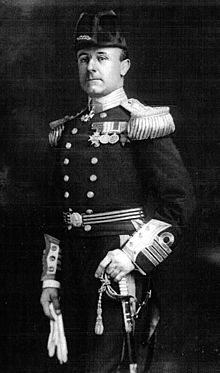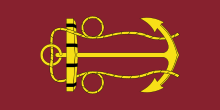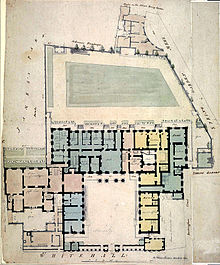Admiralty (UK)
The Admiralty ( English Admiralty ) is a former British authority that was responsible for the management of the Royal Navy until 1964 . Commonly, the various agencies involved in running the Royal Navy are simply called The Admiralty .
Tasks and structure
Originally, the responsibility for running the Royal Navy was given to a single person, the Lord High Admiral . Since the 18th century, however, this task has mostly been carried out by a committee , the Board of Admiralty . The members of this committee have been designated the Lords Commissioner of the Admiralty . Her official title was Commissioners for Exercising the Office of Lord High Admiral of England , later Great Britain or the United Kingdom of Great Britain and (Northern) Ireland . The committee was composed of admirals from the Royal Navy and civilians. The admirals on the Board of Admiralty were referred to as "Sea Lords". There were last five of them, with the First Sea Lord responsible for the operational management of the Royal Navy. The civilians on the Board of Admiralty were mostly well-known politicians and officials. The chairmanship of the entire Board of Admiralty was held by the First Lord of the Admiralty ("First Lord of the Admiralty"), who usually belonged to the cabinet and was always a civilian after 1806. He had political responsibility for the Royal Navy and was sometimes referred to as the "Minister of the Navy" for this reason.
The organization described existed until the second half of the 20th century. 1964 all the previous functions of the Admiralty the newly created this year were of Defense ( Ministry of Defense ) transmitted. New offices were created within the Ministry of Defense, some of which were named after previous authorities. So the supervision of the Royal Navy was transferred to a new Board of Admiralty , which is part of the Tri-Service Defense Council . This new Board of Admiralty only meets twice a year. In daily service, the Royal Navy is managed by the Navy Board (not to be confused with the historic Navy Board , which is described below). At the same time, buildings in which the authorities involved in the management of the Royal Navy were housed are also colloquially referred to as the Admiralty.
Historical development
The office of Admiral of England (or Lord Admiral , later Lord High Admiral ) was created around 1400, although there were already admirals in the northern and western sea areas before that. The Lord High Admiral was an office of the nine Great Officers of State .
In 1546, King Henry VIII created the Council of the Marine , which later became the Navy Board , to oversee administrative matters for the Navy. Operational control of the navy remained the responsibility of the Lord High Admiral .
In 1628 Charles I awarded the office of Lord High Admiral for the first time in commission, d. H. the official business was taken over by a committee (the Board of Admiralty ). Until 1709, the office was led alternately in commission and personally by the Lord High Admiral, then almost constantly in commission until the second half of the 20th century. The future King William IV was the last Lord High Admiral who was actively involved in the leadership of the Royal Navy.
When the office of Lord High Admiral was exercised on commission - and this was the case for most of the 18th, 19th and 20th centuries - the business of office was conducted by the Board of Admiralty . This board was last officially designated as Commissioners for Exercising the Office of Lord High Admiral of the United Kingdom of Great Britain and Northern Ireland (previously of England , Great Britain or of the United Kingdom of Great Britain and Ireland at the respective time). The Board of Admiralty consisted of a number of Lord Commissioners of the Admiralty . The commissioners were always a mixture of admirals , known as Naval Lords or Sea Lords , and civilians, usually politicians. The President of the Board was designated as the First Lord of the Admiralty . He was also a member of the cabinet . After 1806, the First Lord of the Admiralty was always a civilian, while the military leader of the Royal Navy was referred to as the First Sea Lord .
In 1831 the Navy Board was abolished as a separate authority and its duties and responsibilities were transferred to the Admiralty.
In 1964 the Admiralty was combined with the War Office and the Air Ministry in the Ministry of Defense . The Admiralty Board , Army Board and Air Force Board , each headed by the Secretary of State for Defense, exist within the expanded Ministry of Defense . As mentioned earlier, the new Navy Board is responsible for running the day-to-day operations of the Royal Navy .
Organization of the Admiralty
Towards the end of the 19th and beginning of the 20th century, the Admiralty consisted of the following departments:
First Lord of the Admiralty

The First Lord of the Admiralty presided over the entire Board of Admiralty . Mostly it was a politician from the ruling party who usually belonged to the cabinet and who was always a civilian after 1806. He had political responsibility for the Royal Navy. As a member of the Cabinet and Commander-in-Chief of the Navy, the First Lord of the Admiralty played a hinge function between the civilian leadership and the military institution of the Navy. As the responsible minister, he represented the interests of the Royal Navy before Parliament and was in particular responsible for drawing up its budget.
Well-known First Lords of the Admiralty were u. a .:
- George Anson, 1st Baron Anson (1751–1762)
- John Jervis, 1st Earl of St. Vincent (1801-1804)
- George Eden (1834/1835)
- Francis Baring, 1st Baron Northbrook (1849-1852)
- Edward Marjoribanks, 2nd Baron Tweedmouth (1906-1908)
- Reginald McKenna (1908-1911)
- Sir Winston Churchill (1911-1915 and 1939-1940)
- Arthur Balfour (1915-1916)
- Sir Austen Chamberlain (1931)
- Alfred Cooper (1937-1938)
- Brendan Bracken (1945)
Subordinate directly to the First Lord of the Admiralty was the Account-General's Department (Naval Finance) , which, as the office of naval finance , was responsible for budget planning and cash management of the Royal Navy.
First sea lord


The First Sea Lord and Chief of Naval Staff was an admiral and responsible for the military command of the Royal Navy. He was also chief of the admiralty's staff . The Vice Chief of Naval Staff responsible for communications, operations planning and navigation reported directly to him.
Second sea lord
The Second Sea Lord and Chief of Naval Personnel was an admiral and responsible for personnel matters in the Royal Navy.
Third sea lord
The procurement and armaments departments were combined in the Department of the Controller , which was headed by an admiral with the title of Third Sea Lord and Controller of the Navy . Between 1872 and 1892 the Controller of the Navy was not a member of the Admiralty and consequently not a Sea Lord. Until 1905 he temporarily held the title of Third Naval Lord .
The Royal Corps of Naval Constructors was subordinate to the Director of Naval Construction . Its members were responsible for both the design of the warships and the supervision of the work of the shipyards. The duties of the Directors of Naval Construction overlapped with those of the Directors of Dockyards . While the work was commissioned by the Director of Naval Construction, it was checked and approved by the Director of Dockyards.
The Engineer-in-Chief existed as an independent department from 1847 to 1889. Its task was to supervise the design and construction of the ship's machinery. At the beginning of the 20th century, the engineer-in-chief became an independent member of the board as a civil engineer-in-chief .
The Director of Naval Ordnance was responsible for arming the warships. Until 1855 responsibility for all weapons, including the armament of the navy, lay with the Master-General of the Ordnance , who was part of the War Office . The Navy was represented on this committee by an officer.
The Director of Dockyards was responsible for both the administration of the naval yards and the organization of shipbuilding there. At the same time he was responsible for maintenance and repair in all facilities of the Navy.
The Naval Department Store , managed by the Director of Store , was responsible for the procurement and stockpiling of material needed for the construction, assembly and repair of warships, as well as the procurement and stockpiling of ammunition.
Fourth sea lord
The Fourth Sea Lord and Chief of Naval Supplies was an admiral and was responsible for food, supplies (including transport) and medical supplies.
Fifth sea lord
The post of Fifth Sea Lord and Chief of Naval Air Services was introduced during World War I, but abolished after the war. In 1938 it was set up again. He was responsible for flying material and personnel of the Royal Navy ( Royal Naval Air Service or Fleet Air Arm ).
Parliamentary Secretary
The Parliamentary Secretary was a Parliamentary Secretary of State responsible for procurement and contracts.
Permanent Secretary
The Permanent Secretary was an officer responsible for administrative duties and keeping the war diary. The most famous holder of this office was Samuel Pepys in the 17th century .
Admiralty building
The Admiralty Complex is between Whitehall , Horse Guards Parade and The Mall and comprises five buildings. Since the dissolution of the Admiralty as an independent authority, these buildings have been used as offices for various government departments.
The Admiralty
The oldest building was only known as The Admiralty for a long time , but is now colloquially known as the Old Admiralty and officially as the Ripley Building .
It is a three-story, three-wing brick building that was completed in 1726. The architecture of the building is somewhere between baroque and classicism and was described by Alexander Pope as rather boring. It is the first purpose-built office building in Great Britain. It contained a boardroom, other meeting rooms and offices, and apartments for the Lords of the Admiralty. Robert Adam designed the street-side porch, which was added in 1788.
Admiralty House
Admiralty House is a mansion south of the Ripley Building, built in the late 18th century as the residence of the First Lord of the Admiralty. It served that purpose until 1964. Winston Churchill was one of the residents. It does not have its own entrance from Whitehall and is entered through the Ripley Building. It is a three-story yellow brick building with neoclassical architecture and interiors. The rear facade looks directly onto Horse Guards Parade. The architect was Samuel Pepys Cockerell (not to be confused with the Navy Secretary of State and author Samuel Pepys ). There are currently three ministerial apartments in the building.
Old Admiralty Building (Admiralty Extension)
This is the largest building in the Admiralty. It was started in the late 19th century. The design was modified during construction to meet the need for additional offices due to the arms race with the German Reich . It is a red brick building built in Queen Anne style and shows French influences. It is currently used by the Foreign and Commonwealth Office .
Admiralty Arch
Admiralty Arch is connected to the Old Admiralty Building by a bridge and is part of the ceremonial walk from Trafalgar Square to Buckingham Palace . It was designed by Sir Aston Webb , built by John Mowlem & Co , and completed in 1912. Admiralty Arch contains additional office space and is currently being used by the Cabinet Office .
Admiralty Citadel
Admiralty Citadel is a squat windowless bunker from WWII northwest of Horse Guards Parade and now overgrown with ivy.
See also
literature
- Simon Bradley , Nikolaus Pevsner : London. Volume 6: Westminster (= The Buildings of England ). Yale University Press, New Haven CT et al. 2003, ISBN 0-300-09595-3 .
- Stephen W. Roskill : The War at Sea. 1939-1945. Volume 1: The defensive. Her Majesty's Stationery Office, London 1954
- Encyclopædia Britannica. 11th edition. 1910-1922.
Web links
- The Admiralty at the Survey of London online






